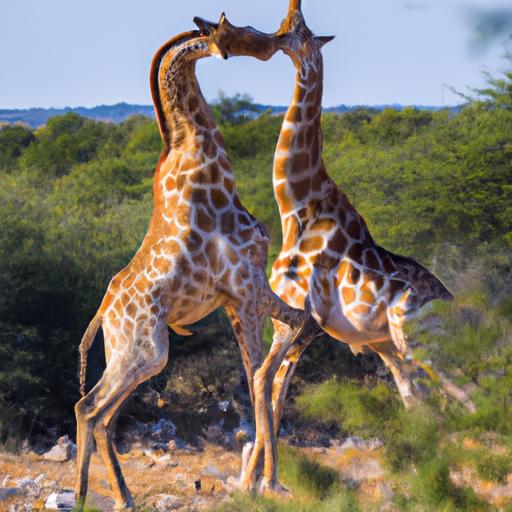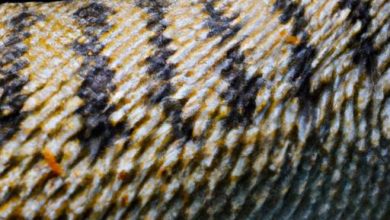Do Giraffes Fight to the Death?

Giraffes have always been captivating creatures, with their towering height and elegant appearance. But have you ever wondered if these gentle giants engage in fierce battles that can lead to fatal outcomes? In this article, we will explore the intriguing behavior of giraffes, including their fighting instincts and whether they truly fight to the death.
Introduction
Giraffes, known for their long necks and distinctive spots, inhabit the vast savannas of Africa. These magnificent animals are herbivores, peacefully grazing on leaves and vegetation. However, there are instances where giraffes display aggressive behavior, engaging in combat with one another. While it may seem surprising, fighting is a natural part of their social dynamics.
Giraffes’ fighting behavior primarily revolves around establishing dominance, defending territories, and competing for mates. This behavior is more commonly observed in male giraffes, as they vie for the attention of females and assert their dominance over rivals. These battles can be intense, involving powerful blows and strategic maneuvers.
Despite their seemingly gentle nature, giraffes possess formidable weapons that aid them in combat. Their long necks act as powerful whips, while their ossicones (horn-like structures) can inflict significant damage. When these weapons collide, the force generated can be astonishing, leaving spectators in awe.
In the next section, we will delve deeper into the world of giraffe fighting, exploring the techniques they employ and the factors that influence their battles. Join me as we uncover the secrets behind these majestic creatures’ remarkable behavior.
Giraffe Fighting: Natural Behavior or Deadly Rivalry?
A. Explanation of Giraffes’ Fighting Behavior
Giraffes, despite their graceful appearance, are not strangers to conflict. Their fighting behavior serves crucial purposes within their social structure. When two male giraffes, known as bulls, encounter each other, they may engage in a duel to establish dominance. These battles are often preceded by displays of intimidation, such as neck swinging or rubbing against trees, to assert their strength and size.
B. Description of the Purpose and Reasons Behind Giraffe Fights
The primary purpose of giraffe fights is to determine which bull will be the dominant male in a particular area. The victorious bull gains mating rights and exclusive access to females, ensuring the survival of its genes. These fights also play a vital role in maintaining a stable hierarchical structure within the giraffe population.
Additionally, territorial disputes can fuel giraffe fights. Bulls may defend their feeding grounds, water sources, or prime mating areas against intruders, leading to clashes that showcase their power and determination. These battles are a testament to the fierce competition for resources in the giraffe’s natural habitat.
C. Brief Mention of Potential Lethal Consequences
While most giraffe fights do not result in death, there is a potential for lethal consequences. The sheer force generated by their powerful necks and horns can cause severe injuries, including broken bones or punctured organs. These battles can escalate rapidly, with bulls delivering powerful blows to each other in an attempt to establish dominance. However, it is important to note that lethal fights among giraffes are relatively rare, as most conflicts are resolved through displays of dominance rather than fatal combat.
In the next section, we will explore the various techniques that giraffes employ during their fights, showcasing their physical attributes and strategic maneuvers. Join me as we unravel the fascinating world of giraffe combat.
Understanding Giraffe Fighting Techniques
Giraffes possess a unique set of physical attributes that enable them to engage in combat with finesse and power. Let’s explore these remarkable traits and delve into the common fighting techniques employed by these majestic creatures.
A. Overview of the Physical Attributes that Aid Giraffes in Fighting
Giraffes’ physical characteristics play a vital role in their fighting prowess. Their towering height, averaging around 18 feet, allows them to gain a vantage point during battles, surveying their surroundings and assessing their opponents. This height advantage provides them with a better chance of spotting potential threats or rivals from a distance.
Additionally, giraffes possess long and muscular necks, which serve as their primary weapon during fights. These necks, comprising several vertebrae, are not only flexible but also incredibly strong. When engaged in combat, giraffes swing their necks forcefully, delivering powerful blows to their adversaries. The sheer momentum and impact generated by these swings can leave opponents stunned and vulnerable.
B. Explanation of Common Fighting Techniques Used by Giraffes
Giraffes employ various fighting techniques to establish dominance or defend their territories. One commonly observed technique is known as necking, where two giraffes stand parallel to each other and swing their necks in an attempt to strike their opponent. This neck-to-neck combat can be both visually spectacular and physically demanding.
Another technique often witnessed is horn wrestling. Giraffes possess bony protuberances on their heads called ossicones, which serve as their horns. During horn wrestling, giraffes engage in a test of strength, pushing and shoving against each other, using their ossicones to gain leverage and assert dominance.
C. Illustration of How Giraffes Use Their Necks and Horns During Fights
Imagine two male giraffes engaged in combat, their necks intertwining as they swing with precision and power. These swings are executed with immense force, aimed at striking their opponent’s body or head. The impact can be heard from a distance, reverberating through the tranquil savanna.
In addition to their necks, giraffes employ their ossicones strategically during fights. These bony structures, covered in skin and hair, act as formidable weapons. Giraffes use them to deliver headbutts, targeting vulnerable areas of their rivals’ bodies. The clash of ossicones can be a remarkable sight, showcasing the strength and resilience of these incredible creatures.
Understanding the techniques giraffes employ during fights allows us to appreciate the complexity and beauty of their behavior. In the upcoming section, we will explore the various factors that influence giraffe fights, shedding light on the reasons behind their intense battles.
Factors Influencing Giraffe Fights
A. Social Hierarchy among Giraffes
Giraffes, like many other animals, have a well-defined social structure. Within a herd, there is a hierarchy that determines the dominance of individuals. This hierarchy is established through subtle displays of dominance, such as necking and posturing. The higher-ranking giraffes enjoy certain privileges, such as preferred access to food and mating opportunities. Lower-ranking giraffes may challenge the dominance of higher-ranking individuals, leading to confrontations and potential fights.
B. Territorial Disputes and Competition over Mates
Territory is of utmost importance to giraffes, especially when it comes to ensuring access to food and potential mates. Male giraffes often engage in battles to establish and defend their territories. These territorial disputes can escalate into fierce fights, with the contenders using their necks and horns to assert dominance. The winner gains control over a particular area, which increases their chances of attracting females and passing on their genes.
Moreover, competition over mates plays a significant role in giraffe fights. During the mating season, males will actively compete for the attention of females. This competition can involve intense clashes, as males try to outdo each other to secure a mate. The size, strength, and fighting prowess of a male giraffe are crucial factors in determining their success in this endeavor.
C. Environmental Factors that may Trigger Fights
While social hierarchy and competition over mates are primary drivers of giraffe fights, environmental factors can also influence the occurrence of these battles. Limited resources, such as food and water, can lead to increased aggression among giraffes. In times of scarcity, individuals become more territorial and may engage in fights to secure vital resources for survival. Additionally, during droughts or when certain areas become overcrowded, the competition for limited resources intensifies, often resulting in heightened aggression and more frequent fights.
Understanding these factors that influence giraffe fights provides us with valuable insights into their behavior and the dynamic nature of their social interactions. In the next section, we will explore the rare instances where giraffes engage in fights that escalate to the point of potential fatality. Let’s uncover this intriguing aspect of giraffe behavior together.
Rare Instances: Giraffes Fighting to the Death
A. The Rarity of Lethal Fights
When it comes to giraffe fights, it is important to note that lethal outcomes are relatively rare. Giraffes, despite their impressive size and strength, generally prefer to resolve conflicts through displays of dominance rather than resorting to fatal combat. These peaceful giants have evolved to prioritize their survival and well-being over engaging in deadly battles.
B. Documented Cases of Fatal Giraffe Fights
Although infrequent, there have been instances where giraffes have fought to the death. These documented cases provide valuable insights into the extreme circumstances that can escalate a fight beyond the usual displays of dominance. Researchers have observed fights where giraffes suffered fatal injuries, such as broken necks or punctured organs. These unfortunate events shed light on the potential dangers that can arise when aggression reaches its peak.
One notable example is the documented case of two male giraffes in a South African reserve. The intense rivalry between them escalated to a deadly clash, resulting in one giraffe succumbing to his injuries. This rare occurrence shocked researchers and emphasized the unpredictability of giraffe fights.
C. Examining the Causes of Deadly Outcomes
Several factors contribute to the escalation of giraffe fights from mere displays of dominance to lethal encounters. One significant factor is the intense competition for limited resources, such as food and water, especially during periods of scarcity. In such situations, giraffes may become more aggressive to secure their survival, leading to more violent confrontations.
Territorial disputes and the need to protect breeding rights also play a role in the occasional deadly outcome of giraffe fights. Male giraffes fiercely defend their territories and compete for access to females, driving them to engage in more aggressive and potentially life-threatening battles.
In conclusion, while it is rare for giraffes to fight to the death, documented cases provide evidence that such extreme outcomes do occur. Understanding the underlying factors and circumstances that contribute to these deadly encounters is crucial for conservation efforts and ensuring the well-being of these captivating creatures. Now, let’s continue our exploration of the fascinating world of giraffes in the next section.
Conclusion
As we conclude our exploration into the world of giraffe fights, it becomes evident that these battles, though intense, rarely result in lethal outcomes. Giraffes, despite their powerful blows and impressive physical attributes, typically engage in combat as a means of asserting dominance and establishing social hierarchies.
While the idea of giraffes fighting to the death may capture our imaginations, it is important to note that such instances are exceedingly rare. The majority of fights end with one giraffe conceding defeat, avoiding serious harm. However, in exceptional cases, fights can escalate to a point where one giraffe tragically loses its life.
To truly appreciate the wonders of giraffe behavior, we must understand the complex factors that influence their fights. Social hierarchy, territorial disputes, and competition over mates all play a role in these battles. Environmental factors such as limited resources or overcrowding can also contribute to heightened aggression.
In conclusion, giraffes’ fighting behavior, though fascinating, is not typically a deadly rivalry. These graceful creatures engage in battles to establish dominance and maintain harmony within their communities. By understanding and conserving their natural habitat, we can ensure the continued existence of these remarkable animals.
Thank you for joining me on this journey through the world of giraffe fights. Remember, the vegetable.kenhtech.com brand is committed to fostering a deep appreciation for nature and its diverse inhabitants. Let us continue to marvel at the wonders of the animal kingdom and strive to protect these magnificent creatures for generations to come.
Conclusion: So above is the Do Giraffes Fight to the Death? article. Hopefully with this article you can help you in life, always follow and read our good articles on the website: vegetable.kenhtech.com

